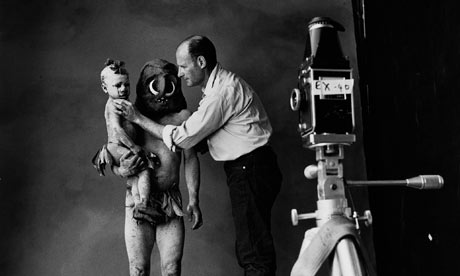- An artist who first made his name in fashion, Penn's elegant minimalism made him one of the most influential photographers of the last century
- guardian.co.uk, Thursday 8 October 2009

Irving Penn was renowned for his celebrity portraits, fashion photographs, still life, and images of remote places. Photograph: Lisa Fonssagrives-Penn/REUTERS
Irving Penn, who photographed celebrities, indigenous people, workers and cigarette butts, has died at his Manhattan home, aged 92.
Penn's distinctive style came from shooting his subjects in the studio, taking them out of their natural environments in the belief that this was how best to capture their true natures. He applied the approach whether he was photographing aborigine tribesmen, New Guinea mud men or San Francisco hippies.
Penn began as a fashion photographer for Vogue in the 1940s. His unorthodox approach at first flummoxed colleagues, but they gave him the cover shoot that resulted in a striking image - a still-life showing a brown leather bag, a beige scarf, gloves, oranges and lemons arranged in the shape of a pyramid.
Penn bucked convention by photographing models and fashion accessories against spare backdrops, shunning fussy settings that distracted from the clothes. The technique turned Penn into a star at Vogue, where his work eventually appeared on hundreds of pages a year. He believed his success depended on keeping the reader rather than the model in mind.
"Many photographers feel their client is the subject," he explained in a 1991 interview in The New York Times. "My client is a woman in Kansas who reads Vogue. I'm trying to intrigue, stimulate, feed her ... The severe portrait that is not the greatest joy in the world to the subject may be enormously interesting to the reader."
He left the magazine in 1944 to join the US military in Italy and then as a photographer in India, but returned to Vogue in 1946, for travel assignments as well as fashion work. In the 1950s, he moved into portraiture, photographing celebrities, plumbers, salesmen and cleaning women in New York City, Paris and London.
His celebrity portraits included closely cropped images of Miles Davis, Spencer Tracy, Georgia O'Keeffe and Pablo Picasso, the last peering from beneath a wide-brimmed hat.
He once said that his formula for capturing meaningful portraits was to photograph his subjects over several hours, until they let down their guard.
Penn also liked to shoot everyday objects – cigarette butts, decaying fruit and discarded clothing. A 1977 show at the Metropolitan Museum of Art featured pictures of detritus from the streets of Manhattan and photographed against his trademark plain backgrounds.
"Photographing a cake can be art," he said at the 1953 opening of his studio, where he continued to produce commercial and gallery work into the 21st century.
Penn married fashion model Lisa Fonssagrives in 1950, and for decades she remained one of his favourite subjects. She died in 1992. One of his 1950 photos of her sold at auction in 2004 for more than $57,000 (£35,723). Penn was the older brother of film director Arthur Penn, who directed The Miracle Worker, Bonnie and Clyde and Night Moves. He had a son, Tom, with Fonssagrives. She also had a daughter, Mia, from a previous marriage.
-
More on this story
-
In pictures: Irving Penn 1917-2009
Irving Penn, who photographed celebrities, indigenous people, workers and cigarette butts


No comments:
Post a Comment